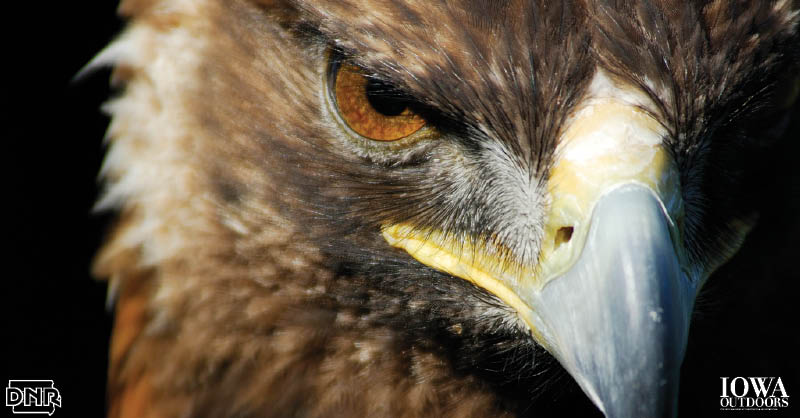 From the January/February 2016 issue of Iowa Outdoors magazine
From the January/February 2016 issue of Iowa Outdoors magazine
Once thought as wanderers from the Rocky Mountains and western states, research shows Iowa’s wintering golden eagles travel thousands of miles from the far, far north.
Mammal Meals
While fish and carrion are primary meals for bald eagles, golden eagle diets contain a variety of small to medium size mammals such as rabbits, fox and squirrels, with an occasional bird or reptile. In the American west, they also eat marmots, and have been observed preying on larger prey such as young pronghorns and bighorn sheep. They generally do not consume fish.
Spread Eagle
Goldens are more widely distributed than any of Earth’s 60 eagle species. Spanning North America from Canada to Mexico (the eagle graces the Mexican flag), goldens range across Europe and Asia and even into North Africa.
Heavy Flier
American golden eagles are somewhat smaller than those from Europe and Asia, but one massive female, banded and released in 2006 in Wyoming, is the heaviest wild golden on record at 17 pounds.
DDT-Free Diet
Unlike bald eagles, goldens escaped DDT contamination as their diet consists of small mammals instead of fish, which were often contaminated with the insecticide. Before it was banned decades ago, this pesticide thinned the eggshells of many birds of prey, but golden eagle numbers were not impacted.
Feathered Tootsies
The roughlegged hawk, ferruginous hawk and golden eagle are the only raptors in the United States with feathers that extend down the legs to the ankles. A golden eagle’s legs are entirely feathered; a bald eagle’s lower legs are bare.
Golden Bullet
When aerially diving after prey (called a stoop), bald eagles can reach 100 mph. Goldens dive even faster, easily hitting 150 mph. In a full dive, some sources put goldens at spectacular speeds near 200 mph, placing them as one of the two fastest animals on Earth next to the peregrine falcon.
Brown-Eyed Beauty
Adult golden eagles have brown or hazel eyes, occasionally with some flecks of gold. Juvenile golden eagles have dark brown eyes.
Like An Owl Pellet, Minus the Bones
Like all raptors, eagles regurgitate a pellet of indigestible portions of their prey approximately 16 to 24 hours after eating. Unlike owls, eagles have powerful stomach acids able to dissolve bones, so an eagle pellet contains just fur or feathers.
Eyes Worth Gold
An eagle eye has two focal points, or fovea, that allow it to see forward and off to the side at about 45 degrees at the same time. The fovea at 45 degrees is used to view things at long distances. An eagle can see something the size of a rabbit running at one to three miles away.
An eagle eye is similar in size to a human eye. Because their eye is so large relative to their size, it fills much of the skull. Each eyeball is fixed in place by ringlets of bone. As such, eagles cannot move their eyeballs within the socket like humans. But they take advantage of 14 neck vertebrae (twice that of humans) to rotate their heads 210 degrees in one direction, two and a half times farther than humans.
